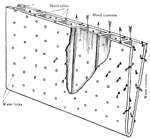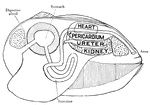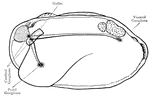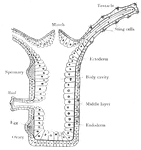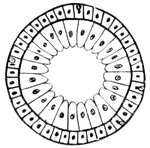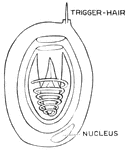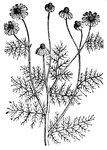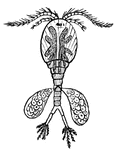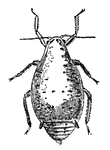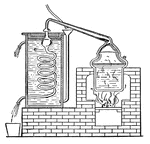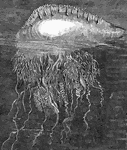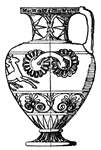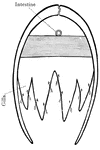
Clam
Cross section of the body of a clam, through the posterior adductor muscles. Arrows indicate water current…
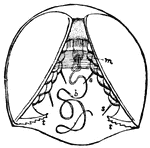
Clam
Young clam, still within the egg membrane. m, adductor muscle; t, hooks by which it attaches itself…
Razor Shell Clam
The razor shell clam has a shell somewhat resembling in shape and size the handle of a razor.

Mackerel
The perch is typical of a large group of fishes, all of which have spiny rays. The perch is widely distributed…
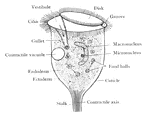
Vorticella
The vorticella is an interesting protozoan. It is found on submerged stems and leaves in stagnant water,…

Sponge
In this simple sponge, water enters minute holes in the sides and passes out of the opening at the top…
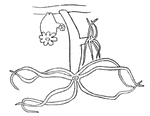
Hydra
If undisturbed, the body and tentacles may occasionally sway gently. If disturbed, a hydra usually shortens…
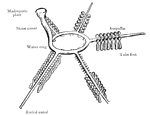
Starfish
The common starfish is a five rayed star. The central body is called the disk and the arms are the rays.…

Balanus
A genus of sessile cirripeds, family Balanidae, of which colonies are to be found on rocks at low water.

Tape-worm
Tape-worms live parasitically within other animals, and are often spoken of as Entozoa. This is a single…

Mite
The mites form with the ticks the order Acarina, and are distinguished by the fact that the abdomen…
Lamprey
The gills in a lamprey are situated in a number of distinct sacs or pouches which recieve water from…
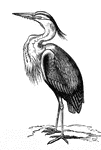
Heron
These wading birds mostly spend their time wading about in shallow water, feeding upon small fishes,…

Archimedes' Screw
A machine used for lifting water, thought to have been invented by Archimedes in egypt for draining…

Artesian Well
A boring in the ground through which currents of water rise from various depths toward or above the…

Liquid Barometer
The liquid barometer is an instrument used in measuring atmospheric pressure. The liquid barometer uses…
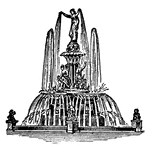
Fountain
A fountain is an artificial basin containing water for drinking or other useful purposes, and connected…

The Great Naval Battle on the Mississippi
First day's bombardment, Federal Schooners off Forts Jackson and St. Philip, commanding the passage…

The Great Naval Battle of the Mississippi
Passage of the second division of the Federal Squadron past Fort St. Philip. On April 24, 1862 at three…
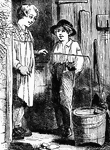
Simple Simon
Simple Simon went a-fishing for to catch a whale. All the water he had got was in his mother's pail.
!["[African American] drivers of the baggage train attached to General Pleasonton's Cavalry brigade watering their mules in the Rappahannock. General Pleasonton's cavalry was attended by a very efficient forage brigade, consisting of mules and [African American] riders. Our sketch represents their drivers taking them to water at the river. The hard work these animals will endure is something wonderful, and justifies the high estimation in which they are held in the army." — Frank Leslie, 1896](https://etc.usf.edu/clipart/11000/11025/baggagetrain_11025_mth.gif)
Baggage Train
"[African American] drivers of the baggage train attached to General Pleasonton's Cavalry brigade watering…
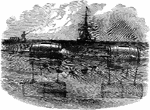
Infernal machine
"Infernal machine designed by the Confederates to destroy the Federal Flotilla in the Potomac discovered…

Westfield
"Fire raft sent down from Fort Jackson to destroy the Federal fleet below the fort- the boats of the…

First naval battle
"First naval battle in Hampton Roads between the Confederate iron-plated steamers Merrimac, Yorktown,…

Second Naval Battle
"Second naval battle in Hampton Roads- fight between the Federal ironclad Monitor, of two guns,…
Occupation of Norfolk
"Occupation of Norfolk, VA., by the Federal troops- view of the city- Federal vessels at anchor." —Leslie,…

Combat at Yazoo River
"Desperate naval combat between the Confederate iron-plated ram Arkansas and the Federal gunboat…

Schooners
"Removing sunken schooners from Core Sound, N. C., placed to obstruct the passage of the Federal gunboats,…

Rolla Camp
"Encampment of the Federal army near Rolla, Mo. The city of Rolla has been famous since the death of…

Warsow Sound
"Reconnoissance of Warsaw Sound, December 5th, 1861, by a detachment of gunboats under Captain Rodgers,…

State Prisoners at Fort Lafayette
"Landing state prisoners at Fort Lafayette, New York harbor, in 1861. Fort Lafayette, New York harbor,…

Burnside Expedition
"The Burnside Expedition- melancholy deaths of Colonel J. W. Allen, Surgeon Waller and the Second Mate…

Camp Wool
"Camp Wool, two miles from Fort Clark, Hatteras Island, occupied by Hawkins's Zouaves, Ninth Regiment,…
